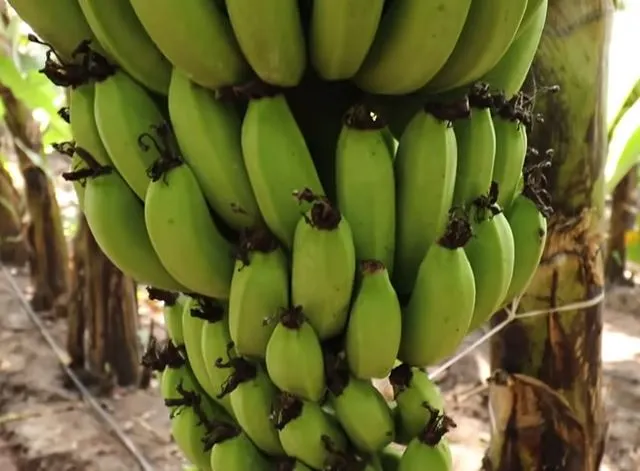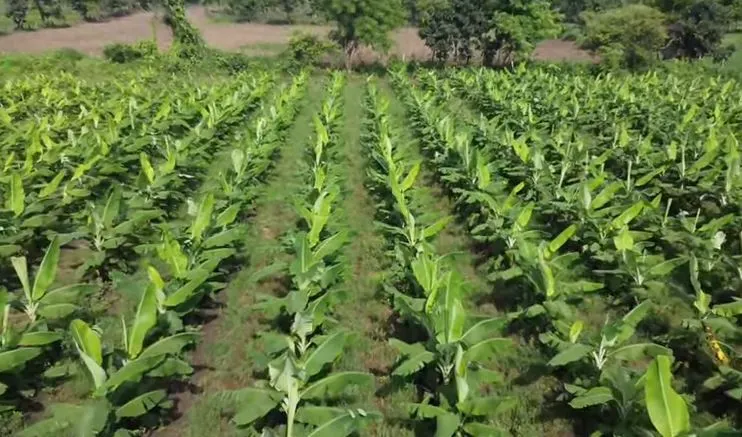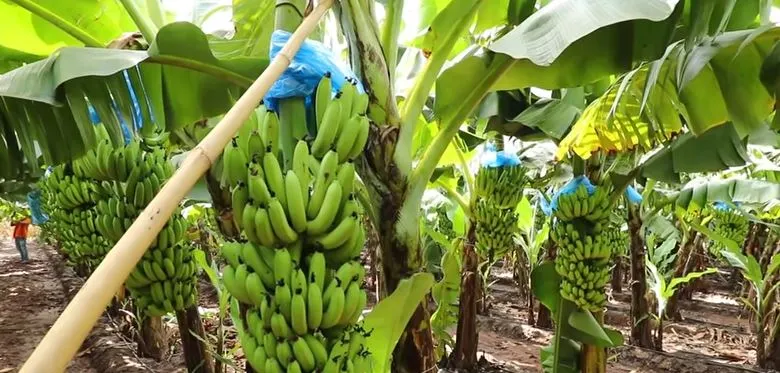Banana Farming Profit Per Acre: 15 Lakh per acre
I. Brief overview of banana farming| Banana Farming Profit Per Acre
Banana farming involves cultivating banana plants, which are tropical plants requiring warm temperatures and consistent moisture. These plants are a staple in many countries due to their versatility and nutritional value.
Importance of understanding profit per acre
Knowing the potential profit per acre helps farmers make informed decisions about investments, resource allocation, and farming practices. It’s crucial for planning and sustainability.
Purpose of the article
This article aims to provide detailed insights into the costs, revenue, and strategies for maximizing profits in banana farming per acre.

II. Initial Investment and Costs | Banana Farming Profit Per Acre
Land acquisition or leasing costs
The first step in banana farming is acquiring land. Whether purchasing or leasing, costs can vary significantly depending on the location and land quality. For instance, prime agricultural land can be expensive, but leasing can be a more affordable option.
Soil preparation and planting
Soil preparation involves plowing, leveling, and preparing the soil for planting. This step ensures the soil is fertile and ready to support banana plants. Costs can include hiring machinery or labor.
Costs of banana seedlings/saplings
Banana farming starts with quality seedlings or saplings. These can be bought from nurseries, with prices ranging based on the variety and quality. Typically, around 1,000 to 1,200 seedlings are needed per acre.
Irrigation and water management
Proper irrigation is crucial for banana farming. Installing an efficient irrigation system, such as drip or sprinkler systems, ensures plants receive adequate water. Initial setup and ongoing water costs need to be factored in.
Fertilizers, pesticides, and other inputs
Bananas require a balanced diet of nutrients. Fertilizers and pesticides are essential to maintain plant health and productivity. Organic or chemical options are available, with costs varying accordingly.
Labor costs for planting and maintenance
Labor is a significant part of the initial investment. Costs include wages for workers involved in planting, weeding, and regular maintenance. Skilled labor can ensure better care and higher yields.
Equipment and machinery costs
Investing in equipment like tractors, plows, and sprayers is necessary for efficient farming. These can be purchased or rented depending on budget constraints.

III. Ongoing Operational Costs | Banana Farming Profit Per Acre
Regular maintenance and care
Routine activities such as weeding, pruning, and fertilizing are essential to maintain plant health. These tasks require continuous attention and incur regular costs.
Labor costs for harvesting
Harvesting bananas is labor-intensive. Skilled laborers are needed to carefully cut the banana bunches without damaging them, which incurs additional costs.
Transportation and logistics
After harvesting, bananas need to be transported to markets or processing facilities. This involves costs related to fuel, vehicle maintenance, and logistics.
Storage and packaging costs
Proper storage is necessary to keep bananas fresh until they reach the market. Additionally, packaging costs include materials and labor to pack bananas in a way that minimizes damage during transport.
Marketing and distribution expenses
Promoting and distributing bananas to various markets also involves costs. These can include advertising, participating in trade shows, and distribution network fees.
IV. Yield and Production | Banana Farming Profit Per Acre
Average yield per acre
The average yield per acre can vary depending on factors like climate and farming practices. On average, farmers can expect around 20 tons of bananas per acre annually.
Factors affecting yield
Several factors influence the yield, including climate conditions, soil fertility, quality of seedlings, and farming techniques. Adverse weather and poor soil can significantly reduce output.
Techniques to improve yield
To improve yield, farmers can adopt high-yielding varieties, efficient irrigation methods, optimal spacing, and integrated pest management practices. These techniques help in maximizing the production potential.
V. Revenue and Profit Calculation | Banana Farming Profit Per Acre
Banana Farming Profit Calculation Per Acre
Planting
– Number of plants per acre: 1,150 plants
– Spacing: 7 feet by 5 feet between plants
Initial Expenses
– Total cost per acre: ₹70,000 to ₹80,000
– Cost of tissue plants: ₹15 per plant
Yield
– Bunch weight per plant: 30 to 35 kg
– Total production: 34,300 kg
Adjusted Production (Considering Climate Impact)
– Adjusted total production: 30,000 kg
Revenue
– Average market rate: ₹45 per kg
– Total revenue: 30,000 kg * ₹45/kg = ₹1,350,000
Profit Calculation
– Total expenses: ₹80,000
– Net profit: ₹1,350,000 – ₹80,000 = ₹1,270,000
Profit Range
– Minimum profit: ₹1,200,000 (12 lakhs) per acre
Maximum potential profit: Could be higher if market rates increase further.
Summary
– Minimum expected profit per acre: ₹12 lakh to 15 lakh
– Potential for higher profit depending on market conditions.
Break-even analysis
A break-even analysis helps determine the point at which revenue covers all costs. This analysis is crucial for understanding when the investment starts yielding profits.

VI. Case Studies and Real-World Examples | Banana Farming Profit Per Acre
Success stories of profitable banana farms
Numerous banana farms have achieved high profitability by adopting best practices. For example, a farm in Ecuador implemented advanced irrigation and organic farming techniques, resulting in significantly higher yields and profits.
Comparative analysis of different regions
Profitability can vary across regions due to differences in climate, soil quality, and market access. Comparing farms in tropical versus subtropical regions can provide insights into optimal conditions for banana farming.
Lessons learned from various farming practices
Insights from successful and less successful farms highlight the importance of proper planning, investment in quality inputs, and effective management practices.
VII. Strategies to Increase Profitability | Banana Farming Profit Per Acre
Implementing modern farming techniques
Modern farming techniques, such as precision farming and mechanization, can enhance efficiency and productivity. Technology aids in better crop management and resource utilization.
Diversifying banana varieties
Growing different banana varieties can cater to various markets and reduce risks. For instance, some varieties might be more resistant to diseases, while others might have higher market demand.
Efficient water and resource management
Using efficient water management practices like drip irrigation and rainwater harvesting can reduce water costs and improve plant health.
Adopting sustainable farming practices
Sustainable practices such as organic farming, crop rotation, and conservation tillage can improve soil health and long-term productivity.
Value addition
Processing bananas into products like chips, puree, or flour can significantly increase revenue. Value-added products often have higher profit margins compared to raw bananas.
Effective marketing strategies
Developing strong branding, engaging in direct marketing to consumers, and participating in farmer’s markets can enhance market presence and sales.
VIII. Risks and Challenges | Banana Farming Profit Per Acre
Common risks in banana farming
Banana farming faces risks from pests (e.g., banana weevil), diseases (e.g., Panama disease), and extreme weather conditions. These can severely impact yields and profitability.
Economic and market risks
Price fluctuations, changes in market demand, and competition pose significant risks. Farmers need to stay informed and adaptable to market trends.
Strategies for risk mitigation and management
To mitigate risks, farmers can adopt crop insurance, diversify their crops, and use resistant varieties. Staying updated with research and developments in banana farming also helps in managing risks effectively.
IX. Conclusion | Banana Farming Profit Per Acre
Summary of key points
Banana farming requires careful planning and investment. Key points include understanding initial and ongoing costs, factors affecting yield, and strategies to maximize profitability.
Final thoughts on the profitability of banana farming per acre
Despite the challenges, banana farming can be highly profitable with the right practices. Success stories and case studies provide encouragement and insights.
Encouragement for prospective banana farmers
For those considering banana farming, the opportunities are vast. With dedication and informed decisions, achieving profitability per acre is within reach.
You Can read this too